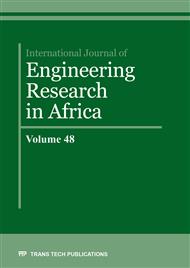[1]
Wind Power As The Fastest Growing Alternative Source Of Energy | REVE,.
Google Scholar
[2]
M. Valentini, V. Akhmatov, F. Iov, and J. Thisted, Fault current contribution from VSC-based wind turbines to the grid,, in 2nd International Symposium on Electrical and Electronics Engineering (ISEEE), (2008).
Google Scholar
[3]
M. Fischer and Â. Mendonça, Representation of variable speed full conversion wind energy converters for steady state short-circuit calculations,, in Transmission and Distribution Conference and Exposition (T&D), 2012 IEEE PES, 2012, p.1–7.
DOI: 10.1109/tdc.2012.6281604
Google Scholar
[4]
H. Margossian, J. Sachau, and G. Deconinck, Short circuit calculation in networks with a high share of inverter based distributed generation,, in Power Electronics for Distributed Generation Systems (PEDG), 2014 IEEE 5th International Symposium on, 2014, p.1–5.
DOI: 10.1109/pedg.2014.6878629
Google Scholar
[5]
G. Balzer, Short-circuit calculation with fullsize converters according to iec 60909,, in 21st Conference of Electric Power Supply Industry, CEPSI, Bangkok, Thailand, (2016).
Google Scholar
[6]
T. Wijnhoven, J. Tant, G. Deconinck, T. Neumann, and I. Erlich, Influence of voltage support by converter based distributed generation on the short-circuit power,, in 2015 IEEE Eindhoven PowerTech, Eindhoven, Netherlands, 2015, p.1–6.
DOI: 10.1109/ptc.2015.7232284
Google Scholar
[7]
W. E. C. Council, WECC wind power plant dynamic modeling guide,, WECC Salt Lake City UT USA, (2014).
Google Scholar
[8]
E. Muljadi and A. Ellis, Final project report WECC wind generator development,, Prep. Natl. Renew. Energy Lab. Univ. California–California Inst. Energy Environ., (2010).
Google Scholar
[9]
W. R. E. M. T. Force, Generic Wind Turbine Generator Models for WECC–A Second Status Report,, in Proc. of IEEE PES General Meeting, (2015).
DOI: 10.1109/pesgm.2015.7285645
Google Scholar
[10]
P. Pourbeik, Model user guide for generic renewable energy system models,, EPRI Rep 3002006525 June, (2015).
Google Scholar
[11]
J. D. Glover, M. S. Sarma, and T. Overbye, Power System Analysis & Design, SI Version. Cengage Learning, (2012).
Google Scholar
[12]
P. Pourbeik, Generic Models and Model Validation for Wind and Solar PV Generation: Technical Update,, EPRI Palo Alto CA, vol. 1021763, (2011).
Google Scholar
[13]
D. Dhua, S. Huang, and Q. Wu, Load flow analysis of hybrid AC-DC power system with offshore wind power,, in 2017 IEEE Innovative Smart Grid Technologies - Asia (ISGT-Asia), Auckland, 2017, p.1–5.
DOI: 10.1109/isgt-asia.2017.8378317
Google Scholar
[14]
E. On, Grid code high and extra high voltage,, E Netz Gmbh Bayreuth Ger., (2006).
Google Scholar
[15]
S. H. A. Aleem, A. Y. Abdelaziz, and A. F. Zobaa, Egyptian Grid Code of Wind Farms and Power Quality,, in Handbook of Distributed Generation, Springer, 2017, p.227–245.
DOI: 10.1007/978-3-319-51343-0_7
Google Scholar
[16]
P. Pourbeik, "WECC Type–4 wind turbine generator model–phase II,, WECC, Tech. Rep., January 23, 2013.[Online]. Available: https://www. wecc. biz/Reliability/WECC% 20Type% 203% 20Wind% 20Turbine% 20Generator% 20Model% 20-% 20Phase% 20II% 20012313. pdf, (2013).
DOI: 10.1109/pesmg.2013.6672398
Google Scholar
[17]
Renewable Energy Model Validation (REMV) Version 2.0," www.epri.com. [Online]. Available: https://www.epri.com/#/pages/product/000000003002003352/,lang=en. [Accessed: 19-Aug-2018].
Google Scholar
[18]
P. Pourbeik, Technical Update – Generic Models and Model Validation for Wind Turbine Generators and Photovoltaic Generation,, PaloAlto, USA, (2013).
Google Scholar
[19]
K. Clark, N. W. Miller, and J. J. Sanchez-Gasca, Modeling of GE wind turbine-generators for grid studies,, GE Energy, vol. 4, p.0885–8950, (2010).
Google Scholar
[20]
P. Pourbeik, Specification of the second generation generic models for wind turbine generators,, Electr. Power Res. Inst. Rep., (2014).
Google Scholar
[21]
Pouyan Pourbeik, Nathan Etzel, and Song Wang, Model Validation of Large Wind Power Plants Through Field Testing,, in 2018 IEEE Transactions on Sustainable Energy.
DOI: 10.1109/tste.2017.2776751
Google Scholar


